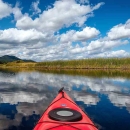Dick describes his childhood growing up in Maine and Massachusetts and the profound interest he had in fishing and hunting since his youth. He enlisted in the Army after college, with his first assignment at Fort Devens being to serve as a liaison to the Nashua River Watershed Association and the Officers Wives Ecology Club. This led to a position, while still an Army officer, with the Army Corps of Engineers in Waltham, MA where he served as a botanist. Dick was on the ground floor of implementation of the National Environmental Policy Act and the Endangered Species Act. Dick then joined the Fish and Wildlife Service in Boston and worked on endangered species issues in the northeast under Paul Nickerson, who until Dick’s hiring, had been the only endangered species biologist in the northeast. Dick liked to take on new challenges every 8 to 10 years, so he worked as the public affairs officer while the position was vacant, but due to lack of Washington Office experience, he did not successfully compete for the position on a permanent basis. However, he did get a position working in support of the North American Waterfowl Management Plan as the coordinator of the Atlantic Coast and Great Lakes Joint Ventures. He was very successful in that position. His last tour of duty was as Refuge Supervisor North in the northeast region (legacy Region 5), where he supervised 21 refuge managers. He describes working with Tony Léger, serving as Tony’s “hunting and fishing conscience”, and he describes some of the special projects and controversial issues he addressed.
Publication date
Media Usage Rights/License
Public Domain
Program
FWS and DOI Region(s)

